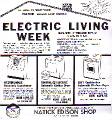Keeping Up with the Joneses: Advertisement in the Town Crier
Local Historians: Melanie Knight, Teddy Burke and Alex Rikleen
The 1950's was a period marked by expansive growth and consumerism in the American economy. This trend, among other national trends at the time, was present in the small town of Wayland. To find evidence of this, one need look no further than the advertisements posted throughout the decade in the Town Crier, the town newspaper.
In analyzing the newspaper, one can find two indicators of economic growth and increased consumerism. These can be found by tracking the percentage of the middle section on the newspaper devoted to advertisements and observing the tactics used by corporations to market their respective products.
The 1950's was a decade during which the phrase "keeping up with the Jones" came into popular use. This phrase was representative of the growing emphasis on material possessions in America and the importance of having the same technology and material wealth in your home as your neighbors, "the Jones". For example, if you were living in a middle class home in suburban America and your neighbor came home with his brand-new television set, you would likely feel pressured to buy a television yourself so as not to seem "behind the times".
A sign of this new attitude could be observed in company's advertisements, which often show a common housewife using her new toaster, washing machine, or whichever worldly possession the company was trying to sell. For example, if you were living in a middle class home in suburban America and your neighbor came home with his brand-new television set, you would likely feel pressured to buy a television yourself so as not to seem "behind the times".
A sign of this new attitude could be observed in company's advertisements, which often show a common housewife using her new toaster, washing machine, or whichever worldly possession the company was trying to sell.
By making the ads depict a "Mrs. Everywoman", people were given the impression that every respectable home contained one of these commodities, and thus consumers felt compelled to buy the new dishwasher,  whether they truly needed it or not. whether they truly needed it or not.

Further evidence of the growing importance of consumerism during this period can be seen in the amount of the newspaper devoted to advertisements versus the space used for the actual stories themselves. In 1952, the Town Crier devoted 55.6% of its available space to advertisements, while in 1959 that figure grew to 61.6%. This growth in advertisements shows the newfound importance of advertisements and consumerism on a local level, and is representative of the nation as a whole during this period.
 Whether for a new two-door fridge, clothes dryer, air-conditioner, or electric razor, demand for and accumulation of material possessions, especially those of a technologically innovative nature, characterized the typical American family. Whether for a new two-door fridge, clothes dryer, air-conditioner, or electric razor, demand for and accumulation of material possessions, especially those of a technologically innovative nature, characterized the typical American family.
This national mindset can be seen in the very advertisements that fueled this consumerism five decades ago, as seen in the Wayland Town Crier.

|

|

|

|

|

|

|

|

|

|

|

|

|

|

|

|

|

|

|

|

|

|

|

|

|

|

|

|

|

Cheaper, faster hot water for your everyday needs! (Crier 2-20-58)
|
|


























